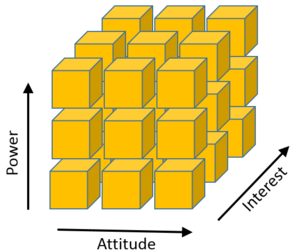Stakeholder Analysis
From apppm
(Difference between revisions)
(→References) |
(→References) |
||
| Line 48: | Line 48: | ||
http://sustainable-learning.org/wp-content/uploads/2012/01/Who’s-in-and-why-A-typology-of-stakeholder-analysis-methods-for-natural-resource-management.pdf | http://sustainable-learning.org/wp-content/uploads/2012/01/Who’s-in-and-why-A-typology-of-stakeholder-analysis-methods-for-natural-resource-management.pdf | ||
| + | * | ||
| + | * | ||
| + | * | ||
* | * | ||
* | * | ||
* | * | ||
Revision as of 17:31, 15 November 2014
Contents |
Abstract
Management of a projects, programs or portfolios happens to be complex and require an extensive overview of several aspects and constraints. But in order to act appropriate and create sustainability the management often has to consider these aspects and constraints not only from their own point of view but also from a number of other stakeholders views.
It is important for the management to know who their stakeholders are and there characteristics in relation to the project, program or portfolio. This might be their influence, impact, interest, attitude etc.
Background
- Dodd (1932)
- Friedman (1962)
- Stanford Institute, SRI (1963)
- Hirschman (1970)
- Friedman (1970)
- Freeman (1984)
- Milgorm and Roberts (1992)
- Donaldson and Preston (1995)
- Freeman (1998)
- Mercier (1999)
- Jensen (2002)
Process
- Identify stakeholders
- Define key stakeholders
- Collect relevant information
- Stakeholder table
- Stakeholder map
- Dealing with stakeholders
Mapping stakeholders
- Why mapping stakeholders?
Types of maps
- 3D mapping
Challenges and uncertainty
Other methods
Methods/tools to use together with the stakeholder analysis
